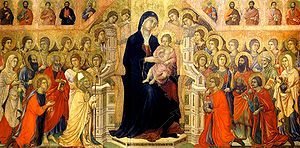Maestà (Duccio)
| Maestà | |
|---|---|
 |
|
| Artist | Duccio di Buoninsegna |
| Year | 1308–1311 |
| Type | Tempera and gold on wood |
| Dimensions | 213 cm × 396 cm (84 in × 156 in) |
| Location | Museo dell'Opera Metropolitana del Duomo, Siena |
|
|
|
|
|
The Maestà, or Maestà of Duccio is an altarpiece composed of many individual paintings commissioned by the city of Siena in 1308 from the artist Duccio di Buoninsegna. The front panels make up a large enthroned Madonna and Child with saints and angels, and a predella of the Childhood of Christ with prophets. The reverse has the rest of a combined cycle of the Life of the Virgin and the Life of Christ in a total of forty-three small scenes; several panels are now dispersed or lost. The base of the panel has an inscription that reads (in translation): "Holy Mother of God, be thou the cause of peace for Siena and life to Duccio because he painted thee thus." Though it took a generation for its effect truly to be felt, Duccio's Maestà set Italian painting on a course leading away from the hieratic representations of Byzantine art towards more direct presentations of reality.
The painting was installed in the cathedral of Siena on 9 June 1311. One person who witnessed this event wrote:
And on that day when it was brought into the cathedral, all workshops remained closed, and the bishop commanded a great host of devoted priests and monks to file past in solemn procession. This was accompanied by all the high officers of the Commune and by all the people; all honorable citizens of Siena surrounded said panel with candles held in their hands, and women and children followed humbly behind. They accompanied the panel amidst the glorious pealing of bells after a solemn procession on the Piazza del Campo into the very cathedral; and all this out of reverence for the costly panel… The poor received many alms, and we prayed to the Holy Mother of God, our patron saint, that she might in her infinite mercy preserve this our city of Siena from every misfortune, traitor or enemy.
Besides the Virgin Mary and the Baby Jesus, saints depicted in the painting include John the Evangelist (to the left of the throne); Saint Paul; Catherine of Alexandria; John the Baptist (to the right of the throne); Saint Peter; and Saint Agnes. In the foreground are Siena’s various patron saints: Saint Ansanus; Saint Sabinus; Saint Crescentius; and Saint Victor.
...
Wikipedia
